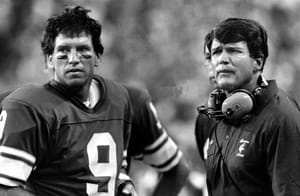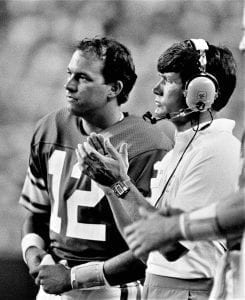Les Steckel’s Brightest Moment

The Vikings Third Head Coach, Les Steckel, Lasted One Season. There Were Reasons.
Part three of a nine-part series detailing the first win of every head coach of the Minnesota Vikings.
By Roger Dier
Les was not more.
The Vikings third head coach was 38-year-old Les Steckel. Before he was named head coach in 1984, Steckel was golden gloves boxing champion, a former Marine, a Vietnam veteran, religiously devout, he volunteered on Robert Kennedy’s 1968 campaign for President, and he served as an assistant coach to the 49ers Bill Walsh (1978) and Bud Grant (1979-83).
Steckel was also the worst head coach in Vikings history, so wrote Sid Hartman in the Minneapolis Star-Tribune on Nov. 26, 2011. Sid did not exaggerate. Steckel lasted one year and went 3-13. His team scored 276 points in 16 games and surrendered 484—the defense gave up an average of 40 points per game in the last six contests—and the Vikings lost that sextet of games by an average of 27 points. One of those losses, 51-7 to the 49ers, remains as the worst shellacking in team history.
Steckel was an in-your-face head coach of a veteran Vikings team, that, as the season wore on, was turned off by Steckel and turned away. “I’ve led 210 Marines and 80 Vietnamese soldiers into combat, so don’t talk to me about being a head coach,” Steckel said before the season began. The first day of training camp featured a grueling menu of drills—an eight-event ironman contest—to test the physical condition of players. Practices throughout the season concluded with sprints—gassers in coachspeak—and other activities like rope climbing to condition players. The Vikings, professional athletes all, slowly signaled during the season that they were not interested in joining Steckel in his march to Pretoria, or into 1985. “He tried to run a professional team with a high school attitude,” linebacker Scott Studwell of Steckel.
That aside, Steckel did have a day in which he won his first NFL game.
After an ominous season-opening 42-13 loss at San Diego, the Vikings played better in a 19-17 loss at Philadelphia. Fortunately, 0-2 Atlanta came into the Metrodome on Sept. 16, 1984 to take on the Vikings. On game day, Steckel made a promise to his team: “I told the team that we were going to go out there today and be riverboat gamblers.”
The first half featured a place-kicking exhibition between Atlanta’s Mick Luckhurst and the Vikings’ Jan Stenerud. Luckhurst hit from 33 and 43 yards and Stenerud’s field goals were from short (22 yards) and long (54 yards).
In the second half, Steckel freed his inner gambler. “I wanted to keep my promise to them,” Steckel said.
Facing a third-and six at the Vikings 45, quarterback Tommy Kramer did a Statue of Liberty play, faking a pass and handing off to running back Darrin Nelson, who took it up field for 13 yards. The drive ended up with a conventional Kramer-to-Leo Lewis touchdown pass from 42 yards.
Later in the game, leading 20-13, wide receiver Billy Waddy took a handoff on a reverse for 11 yards to the Vikings 34. After Kramer was sacked, Kramer pitched to fullback Alfred Anderson, who handed the ball off to Nelson for 27 yards and new downs. On first down, Kramer lateraled the ball to Anderson, now playing halfback, who floated a beautiful pass to receiver Dwight Collins for a 43-yard touchdown.
“Collins did a helluva job on that play,” Kramer said. “He went downfield and faked like he was blocking the corner. The corner bit and Dwight took off.”
Late in the fourth quarter, Atlanta got a garbage time touchdown from Steve Bartkowski Billy Johnson to make the final 27-20.
The Vikings out-yarded Atlanta 414-258 and they sacked Bartkowski seven times. Kramer was sacked twice.

Quarterback Steve Dils was signed by the Vikings late in the 1984 season. He never played a down for Les Steckel.
EXTRA POINTS: The Vikings followed up the Atlanta win by beating Detroit 29-28 on the road, which evened Minnesota’s record at 2-2. Had the world ended then, Steckel would have been remembered by survivors as a mediocre coach. The world did not end, however, and Steckel coached the Vikings to a 1-11 record the rest of the way. Minnesota’s last Steckel-era loss, 38-14 at home to the Packers, occurred on Dec. 16, 1984.
The next morning, Les was gone from the Vikings.
He would not be missed: “I sense a huge sigh of relief,” said Doug Martin. Studwell said “[Steckel] alienated a lot of people and it was getting pretty ugly around here. He didn’t listen to this players.”
Nor did the Vikings block for Steckel’s quarterbacks Kramer, Wade Wilson and Archie Manning. The Vikings gave up 64 sacks in 1984. Manning, 35 years old that season, was sacked 11 times in a 16-7 loss at Chicago. Watching that game on television, I thought the Bears were going to kill Archie or convince him to retire. Archie chose the latter.
Vikings general manager Mike Lynn’s hiring of Steckel was one of two big mistakes that Lynn made during his tenure in Minnesota. The other big blunder occurred in October 1989, when he traded away a first-round draft choice plus five players (linebackers David Howard and Jesse Solomon, running back Darrin Nelson, cornerback Issiac Holt and defensive end Alex Stewart), which Dallas opted to convert to draft choices, all in the first three rounds. Walker was in Minnesota for three seasons and never had a season where he rushed for 1,000 yards. On the day of the trade, Cowboys coach Jimmy Johnson crowed that it the Cowboys had just executed “the great train robbery.” The trade propelled the Cowboys to three Super Bowl titles in the 1990s.
SOURCES
Minneapolis Star-Tribune
Profootballreference.com
Minnesota Vikings
Newspapers.com
ABOUT ROGER DIER: Roger serves as the Wisconsin correspondent for Purpleptsd.com and vikingsterritory.com. He has written two books, covered the Vikings for the Mankato Free Press and in relief for the Associated Press, and has contributed to various magazines and newspapers that reflect his interests. The one remaining goal in his life is to appear as a guest on the purpleptsd podcast.
